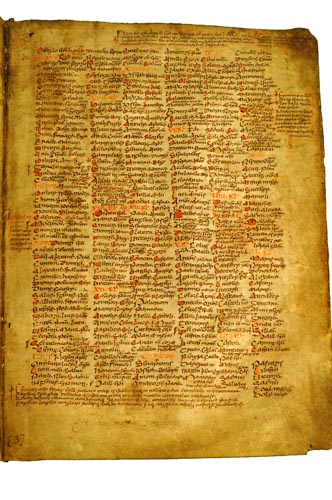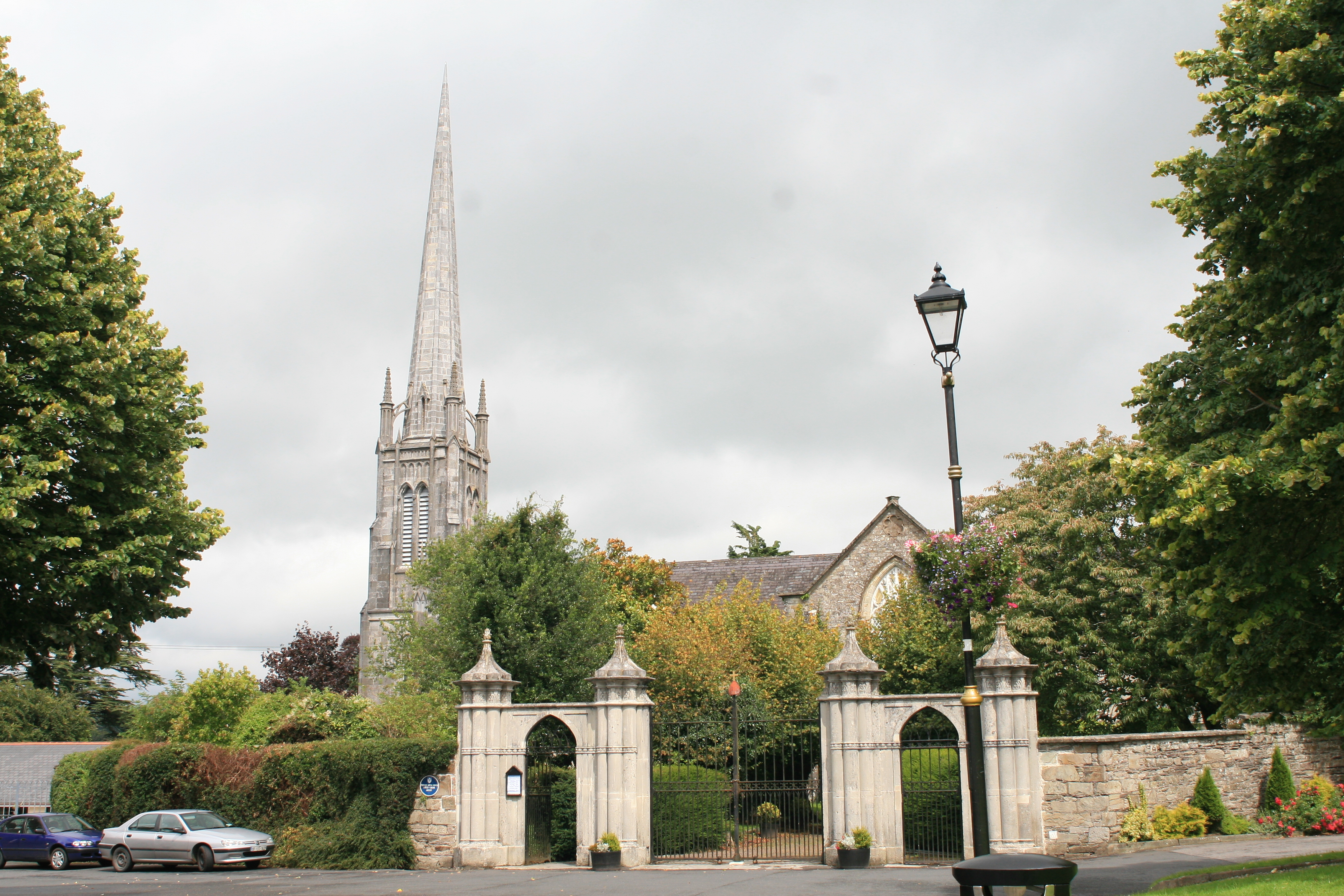|
Fiodhairle
Saint Fiodhairle Ua Suanaigh (or Fidharleus, Fidarle, Fidairle, died 762) was an Irish abbot who was considered to be a saint. His feast day is 1 October. Life Fiodhairle Ua Suanaigh was an 8th-century abbot of the monastery in Rahan, County Offaly. He is said to have belonged to the Hy Fiachrach family, as did Saint Colman mac Duagh, Colman of Kilmacduach, and to have been a brother to Fiodhmuine Ua Suanaigh. The Bollandists refer to Colgan and give his feast day as 1 October. The ''Martyrology of Tallaght'' also says his feast day was 1 October. The ''Martyrology of Marianus O'Gorman'' says he was a "white-fair prince" and notes his Suanach descent and Rathen abbey. The 17th-century ''Martyrology of Donegal'' says he died in 762. Older spellings of the Rahan abbey name are Rathen, Raithen and Raithean, meaning "ferney place". The O'Swany (Ua Suanaigh) family were the hereditary successors to Saint Carthage at the abbey from the 8th century. Fiodhairle repaired the abbey after a ... [...More Info...] [...Related Items...] OR: [Wikipedia] [Google] [Baidu] |
Rahan, County Offaly
Rahan () is a parish and village in County Offaly, Ireland. It is associated with Mochuda (also known as St. Carthage). The village is located on the banks of the river Clodagh approximately 8 km from Tullamore. The parish of Rahan extends from The Island near Ballycumber in the north to Mucklagh in the south. History First monastery The first monastery in Rahan was created by Camelacus in the 5th century and later re-founded in the 6th century by St Carthage. The ancient monasteries and churches located here are known as the church of St Carthage or St Carthach, and the monastery of Mochuda.RAHAN MONASTIC SITE - A Conservation Plan (PDF) Saint [...More Info...] [...Related Items...] OR: [Wikipedia] [Google] [Baidu] |
Colman Mac Duagh
Saint Colman mac Duagh (c. 560 – 29 October 632) was born at Corker, Kiltartan, County Galway, Ireland, the son of the Irish chieftain Duac (and thus, in Irish, ''mac Duach''). He initially lived as a recluse, living in prayer and prolonged fastings, first on Inismore, then in a cave at the Burren in County Clare. With his relative, King Guaire Aidne mac Colmáin (d. 663) of Connacht he founded the monastery of Kilmacduagh, ("the church of the son of Duac"), and governed it as abbot-bishop. He has been confused with Saint Colman of Templeshanbo (d. 595) who was from Connacht and lived somewhat earlier. Early life St Colman was reportedly the son of Queen Rhinagh and her husband the chieftain Duac, born in Kiltartan, now County Galway. Priesthood He was educated at Saint Enda's monastery on Inishmore/''Árainn'', the largest of the Aran Islands and lived there as a hermit. He built a church, ''Teampuill Mor Mhic Duagh'', and a small oratory, ''Teampuill beg Mhic Duagh'', ... [...More Info...] [...Related Items...] OR: [Wikipedia] [Google] [Baidu] |
Bollandist
The Bollandist Society ( la, Societas Bollandistarum french: Société des Bollandistes) are an association of scholars, philologists, and historians (originally all Jesuits, but now including non-Jesuits) who since the early seventeenth century have studied hagiography and the cult of the saints in Christianity. Their most important publication has been the ''Acta Sanctorum'' (The Lives of the Saints). They are named after the Flemish Jesuit Jean Bollandus (1596–1665). ''Acta Sanctorum'' The idea of the ''Acta Sanctorum'' was first conceived by the Dutch Jesuit Heribert Rosweyde (1569–1629), who was a lecturer at the Jesuit college of Douai. Rosweyde used his leisure time to collect information about the lives of the saints. His principal work, the 1615 ''Vitae Patrum'', became the foundation of the ''Acta Sanctorum''. Rosweyde contracted a contagious disease while ministering to a dying man, and died himself on October 5, 1629, at the age of sixty. Father Jean Bollandus wa ... [...More Info...] [...Related Items...] OR: [Wikipedia] [Google] [Baidu] |
Martyrology Of Tallaght
The ''Martyrology of Tallaght'', which is closely related to the '' Félire Óengusso'' or ''Martyrology of Óengus the Culdee'', is an eighth- or ninth-century martyrology, a list of saints and their feast days assembled by Máel Ruain and/or Óengus the Culdee at Tallaght Monastery, near Dublin. The '' Martyrology of Tallaght'' is in prose and contains two sections for each day of the year, one general and one for Irish saints. It also has a prologue and an epilogue.Welch, Robert, & Bruce Stewart, ''The Oxford Companion to Irish Literature'' (Oxford University Press, 1996, )p. 359at google.co.uk ''Prologue'' and Irish paganism The prologue contains a famous verse on the declining pagan faith in Ireland: ''Senchatraig na ngente/iman roerud rudad/itfossa can adrad/amail Lathrach Lugdach.'' ''Ind locáin rogabtha/dessib ocus trírib/it rúama co ndálib/co cétaib, co mílib.'' which reads in translation as ''The old cities of the pagans to which length of occupation ... [...More Info...] [...Related Items...] OR: [Wikipedia] [Google] [Baidu] |
Martyrology Of Donegal
A martyrology is a catalogue or list of martyrs and other saints and beati arranged in the calendar order of their anniversaries or feasts. Local martyrologies record exclusively the custom of a particular Church. Local lists were enriched by names borrowed from neighbouring churches. Consolidation occurred, by the combination of several local martyrologies, with or without borrowings from literary sources. This is the now accepted meaning in the Latin Church. In the Eastern Orthodox Church, the nearest equivalent to the martyrology is the Synaxarion and the longer Menologion. As regards form, one should distinguish between simple martyrologies that simply enumerate names, and historical martyrologies, which also include stories or biographical details; for the latter, the term ''passionary'' is also used. Oldest examples The martyrology, or ''ferial'', of the Roman Church in the middle of the fourth century still exists. It comprises two distinct lists, the ''Depositio martyr ... [...More Info...] [...Related Items...] OR: [Wikipedia] [Google] [Baidu] |
Saint Carthage
Saint Mo Chutu mac Fínaill (died 14 May 639), also known as Mochuda, Carthach or Carthach the Younger (a name Latinized as ''Carthagus'' and Anglicized as Carthage ),William Henry Grattan Flood (1908). "St. Carthage". In ''Catholic Encyclopedia''. 3. New York: Robert Appleton Company. The Roman Missal (Veritas 2011; ), p. 760 was abbot of Rahan, County Offaly and subsequently, founder and first abbot of Lismore (Irish ''Les Mór Mo Chutu''), County Waterford.Johnston, "Munster, saints of (act. ''c''. 450–''c''. 700)." The saint's ''Life'' has come down in several Irish and Latin recensions, which appear to derive from a Latin original written in the 11th or 12th century. Life Through his father, Fínall Fíngein, Mo Chutu belonged to the Ciarraige Luachra, while his mother, Finmed, was of the Corco Duibne. Notes added to the '' Félire Óengusso'' (the Martyrology of Óengus) claim that his foster father was Carthach mac Fianáin, that is Carthach the Elder, whose period of ... [...More Info...] [...Related Items...] OR: [Wikipedia] [Google] [Baidu] |
Vikings
Vikings ; non, víkingr is the modern name given to seafaring people originally from Scandinavia (present-day Denmark, Norway and Sweden), who from the late 8th to the late 11th centuries raided, pirated, traded and settled throughout parts of Europe.Roesdahl, pp. 9–22. They also voyaged as far as the Mediterranean, North Africa, Volga Bulgaria, the Middle East, and North America. In some of the countries they raided and settled in, this period is popularly known as the Viking Age, and the term "Viking" also commonly includes the inhabitants of the Scandinavian homelands as a collective whole. The Vikings had a profound impact on the early medieval history of Scandinavia, the British Isles, France, Estonia, and Kievan Rus'. Expert sailors and navigators aboard their characteristic longships, Vikings established Norse settlements and governments in the Viking activity in the British Isles, British Isles, the Faroe Islands, Settlement of Iceland, Icela ... [...More Info...] [...Related Items...] OR: [Wikipedia] [Google] [Baidu] |
St Augustine's Abbey, Ramsgate
St Augustine's Abbey or Ramsgate Abbey is a former Benedictine abbey in Ramsgate. It was built in 1860 by Augustus Pugin and is a Grade II listed building. It was the first Benedictine monastery to be built in England since the Reformation. In 2010, the monks moved to St Augustine's Abbey in Chilworth, Surrey. The site is now owned by the Vincentian Congregation from Kerala, India. The church of St Augustine, across the road from the abbey site, belongs to the Archdiocese of Southwark and is a shrine of St Augustine of Canterbury. History Augustus Pugin had built his home, The Grange, in Ramsgate, and St Augustine's Church next door. He donated the church to the Catholic Diocese of Southwark before his death in 1852, and The Grange remained in private hands. In 1856, the Bishop of Southwark, Thomas Grant, invited the Subiaco Cassinese Congregation of the Benedictines to form a monastic community in Kent and take over the running of the church. The abbey was built acros ... [...More Info...] [...Related Items...] OR: [Wikipedia] [Google] [Baidu] |
Alban Butler
Alban Butler (13 October 171015 May 1773) was an English Roman Catholic priest and hagiographer. Biography Alban Butler was born in 1710, at Appletree, Aston le Walls, Northamptonshire, the second son of Simon Butler, Esq. His father died when he was young and he was sent to the Lancashire boarding school ran by Dame Alice. He went on to a Catholic further education at the English College, Douai, in France. In 1735 Butler was ordained a priest. At Douai, he was appointed professor of philosophy, and later professor of theology. It was at Douai that he began his principal work ''The Lives of the Fathers, Martyrs and Other Principal Saints''. He also prepared material for Richard Challoner's ''Memoirs of Missionary Priests'', a work on the martyrs of the reign of Elizabeth. In 1745, Butler came to the attention of the Duke of Cumberland, younger son of King George II, for his devotion to the wounded English soldiers during the defeat at the Battle of Fontenoy. Around 1746, Butle ... [...More Info...] [...Related Items...] OR: [Wikipedia] [Google] [Baidu] |
Medieval Saints Of Leinster
In the history of Europe, the Middle Ages or medieval period lasted approximately from the late 5th to the late 15th centuries, similar to the post-classical period of global history. It began with the fall of the Western Roman Empire and transitioned into the Renaissance and the Age of Discovery. The Middle Ages is the middle period of the three traditional divisions of Western history: classical antiquity, the medieval period, and the modern period. The medieval period is itself subdivided into the Early, High, and Late Middle Ages. Population decline, counterurbanisation, the collapse of centralized authority, invasions, and mass migrations of tribes, which had begun in late antiquity, continued into the Early Middle Ages. The large-scale movements of the Migration Period, including various Germanic peoples, formed new kingdoms in what remained of the Western Roman Empire. In the 7th century, North Africa and the Middle East—most recently part of the Eastern Roma ... [...More Info...] [...Related Items...] OR: [Wikipedia] [Google] [Baidu] |

.jpg)




